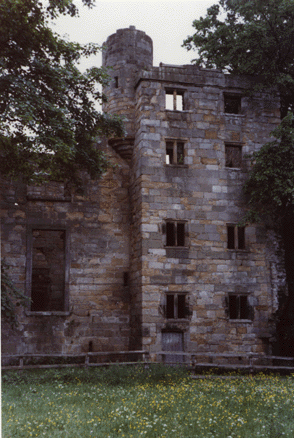The Dilston Heritage Project
For centuries Dilston has been a source of fascination and inspiration for those who visit. The tranquil beauty of the site and the story of the ill-fated Earl, which ranks as one of the most moving episodes in Northumbrian history, has led over the years to a string of poems, novels, biographies and other creative works. Yet despite its historic importance, the Radcliffe heritage, hidden away in private grounds, was gradually becoming neglected and almost forgotten. The romance of the Derwentwater Legend, which had lived on in Hexhamshire long after the demise of the family and the demolition of Dilston Hall, was by the late twentieth century beginning to fade. Concern for the crumbling remains of Dilston Castle and the associated Radcliffe heritage finally instigated the start of a conservation programme for the site.
The romance of the Derwentwater Legend, which had lived on in Hexhamshire long after the demise of the family and the demolition of Dilston Hall, was by the late twentieth century beginning to fade. Concern for the crumbling remains of Dilston Castle and the associated Radcliffe heritage finally instigated the start of a conservation programme for the site.
Dilston Castle
In 1993, the Dilston Heritage Project was launched in order to conserve the remaining Radcliffe heritage and bring attention to this important historic site, which is situated on a gently sloping hillside to the south-west of Corbridge, a village in the Tyne Valley. On the western outskirts of Corbridge, the remains of the Roman station of Corstopitum can be seen, and from here the site of a bridge can be located that once carried the Roman road, Dere Street, across the Tyne. Dere Street ran across the haugh land on the south side of the river, passing not far from Dilston. A Roman gravestone and other ancient stones are built into the walls of Dilston Chapel.
In 2001,
the Heritage Lottery Fund and English Heritage awarded grants for the
conservation and restoration of Dilston Castle and Chapel, and work on the two
scheduled ancient monuments was completed by July 2003. The restoration of
Dilston Castle and Chapel was a joint enterprise undertaken by the Historic
Dilston Group, the North Pennines Heritage Trust (the building trust that
carried out the work), and Dilston College, MENCAP (who, at the time, owned the
two buildings, which stand in the grounds). The project was
supported by The Fifteen (The
Northumbrian Jacobite Society). Further grant aid was subsequently
obtained to carry out repairs to the Lord's Bridge and conserve various
historical features around the site.
The North Pennines Heritage Trust went into administration in Sept. 2011, and
so their lease on the Castle and Chapel returned to Dilston College and the
activities of the Historic Dilston Group there ceased. The precious buildings
on the heritage site remained inaccessible to the public until The
Cambian Group, the new owners of the College, signed a tenancy agreement in
October 2015 with John Nicholls MBE, then Chairman and now Hon. Life President
of The Fifteen (The Northumbrian
Jacobite Society), so that the Castle, Chapel and site could be maintained
and improved and some access by like-minded groups and interested members of
the general public be made possible; this has to be by prior arrangement, under
supervision and at times approved in advance by Cambian Dilston College, which
has a duty of care towards its students and whose grounds are normally closed
to the general public. For enquiries about visits, info@northumbrianjacobites.org.uk
Visitors to the site (by prior appointment only - see above) are able to follow the story of the Radcliffes of Dilston and the Jacobite Cause on graphic displays inside the Castle and Chapel. They can climb the restored staircase inside the Castle and learn how the 15th-century tower house (which still survives) was incorporated into Dilston Hall, the palatial Queen Anne mansion built by James Radcliffe, 3rd Earl of Derwentwater, but demolished some years after his attainder and execution. A particular point of interest is the Chapel, which has been restored to its original state, as built by Sir Francis Radcliffe, c.1616-21. This includes a new oak gallery, which was installed to replace the one that was removed in 1733, when the chapel was refurbished to suit the Church of England.
The Fifteen (The Northumbrian Jacobite Society) was founded in 2000 to
promote interest in the Northumbrian Jacobites, principally (but not
exclusively) those participating in the 1715 Jacobite Rising (The Fifteen).
Its leaders included James Radcliffe, 3rd Earl of Derwentwater, and his brother
Hon. Charles Radcliffe, who lived at Dilston.